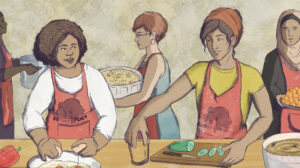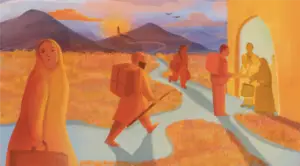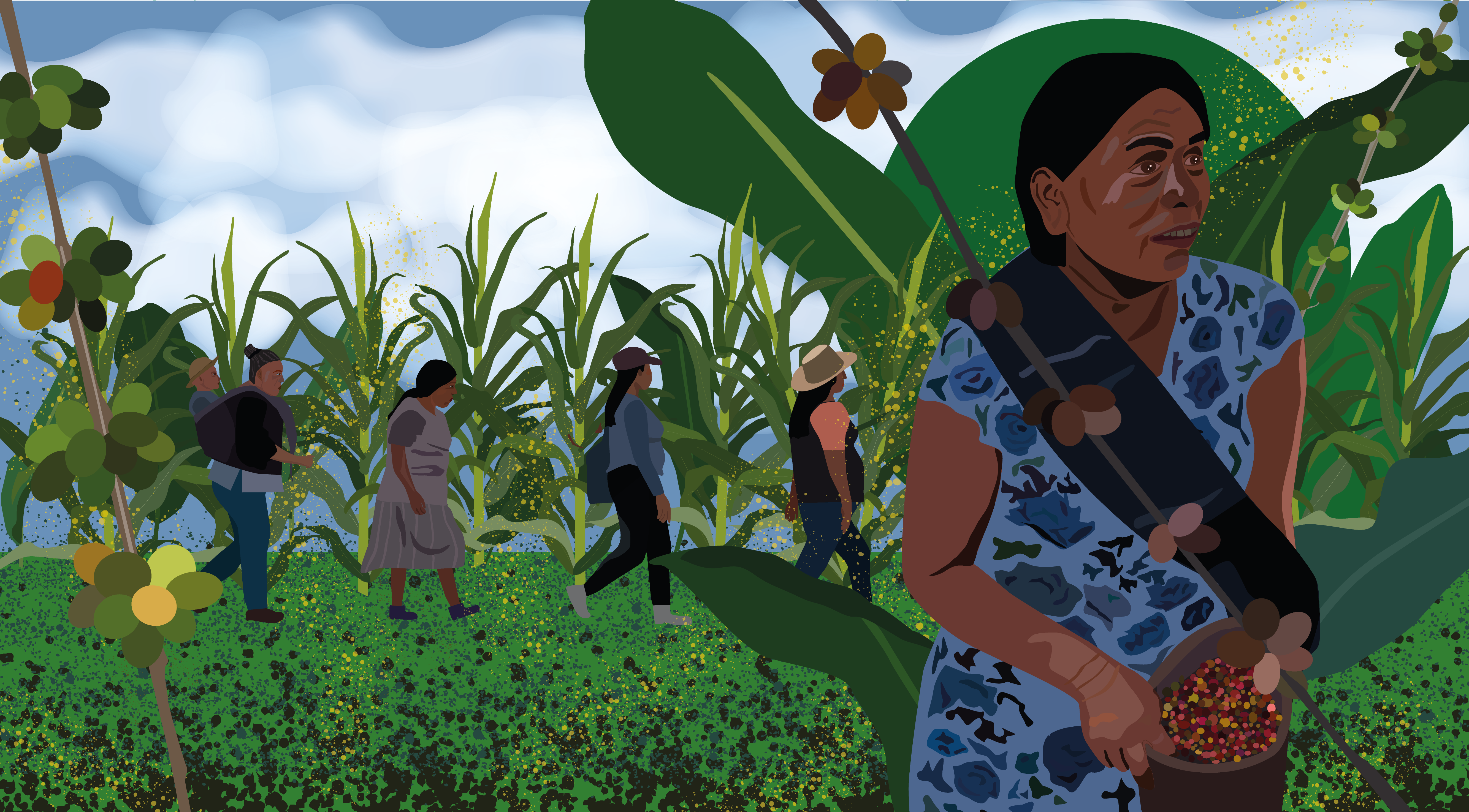
How indigenous women farmers in Mexico are using agroforestry to save the world’s favorite drink
- Written by Magdalena Rojo
- Photos by Noel Rojo
- Illustration by Maryna Natkhir
Coffee producers in Oaxaca, Mexico, are adapting to climate change by restoring their coffee plantations in agroforestry systems. While the costs of their work are increasing, the price of coffee is not.
Seven women gather beneath the shade of Victórica Ortiz López’ (58) house, their woven bags slung over their arms and ready for the fields. Speaking in Mixteco, the majority of these women are above fifty and still prefer the traditional indigenous language over Spanish. In Guadalupe Buenavista, a village of around 400 people, coffee production has been the main source of income for multiple generations. “My grandfather, who is already 80, spent all his life growing coffee and so did his father,” says one of the youngest coffee producers, Paula Pérez Ortiz (34), while we wait for a pick-up to take us along the bumpy, unpaved roads.
Once we leave the village for the coffee plantations, forests are everywhere around us. Here, coffee plants grow underneath trees.
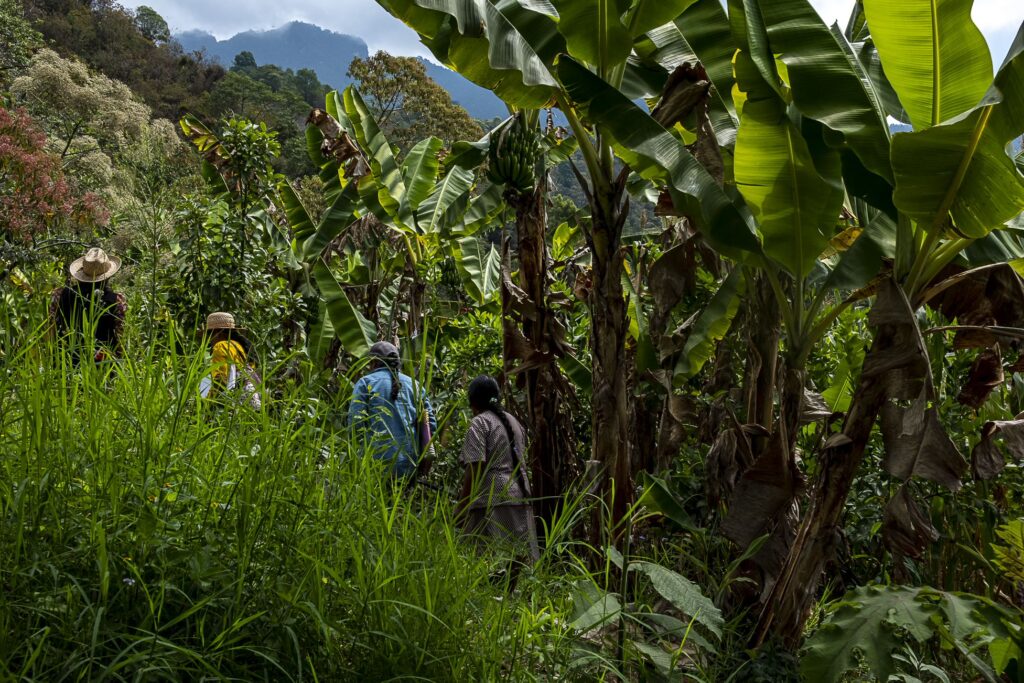
Mexico is famous for its arabica coffee, often grown in the shade of different kinds of trees instead of monocultures, where only coffee plants would grow in one plantation. The country is amongst the biggest exporters of organic coffee in the world, with Germany being one of its main importers.
However, the small producers of the Mexican state of Oaxaca have found it increasingly difficult to cultivate this commodity due to the unpredictable weather patterns and diseases brought on by climate change. As a result, many people have abandoned their plantations and migrated. In the past decade migration in the four states with the highest Mexican coffee production – Chiapas, Veracruz, Puebla, and Oaxaca – increased by 18.9 per cent.
"It was in 2015 when I lost many of my plants due to coffee rust," says Ortiz López as she stands by her new Geisha variety plants, which she planted shortly after the incident.
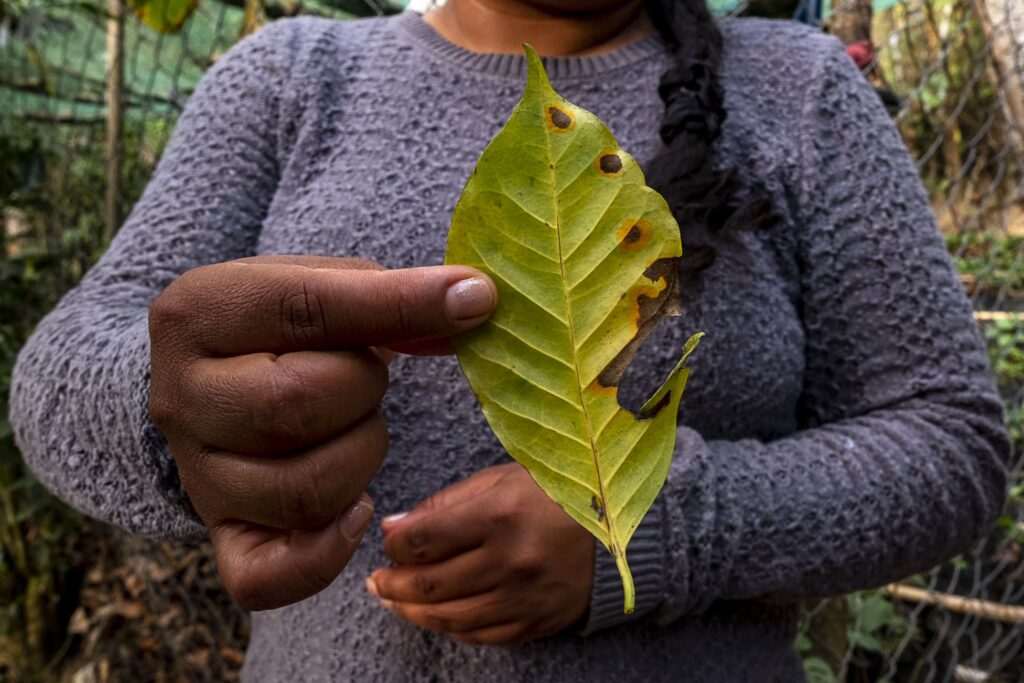
Back then, many plants died due to the coffee rust or Hemileia vastatrix, a fungus that thrives in humid, warm environments. It affects the leaves of coffee plants, creating dark spots and later, making them yellow until they lose their ability for photosynthesis and eventually the plant stops producing coffee cherries. With rising temperatures due to climate change, it climbs into higher altitudes. More than half of the coffee production in Oaxaca was lost due to this parasitical fungus eight years ago. Many people migrated back then.
In Buenavista, every woman we talk to has some family member on the other side of the northern border. La Mixteca region in Oaxaca has some of the poorest regions in Mexico in general and migration has for decades been a strategy for families to make ends meet. As men migrate, women are often the ones passing on the knowledge as to how to grow coffee.
They have been growing coffee in agroforestry systems, which makes the plants resist challenges that come with climate change. Growing more resistant varieties surrounded by other trees for diversification is the way local Mixtec people have been able to recover their coffee plantations.
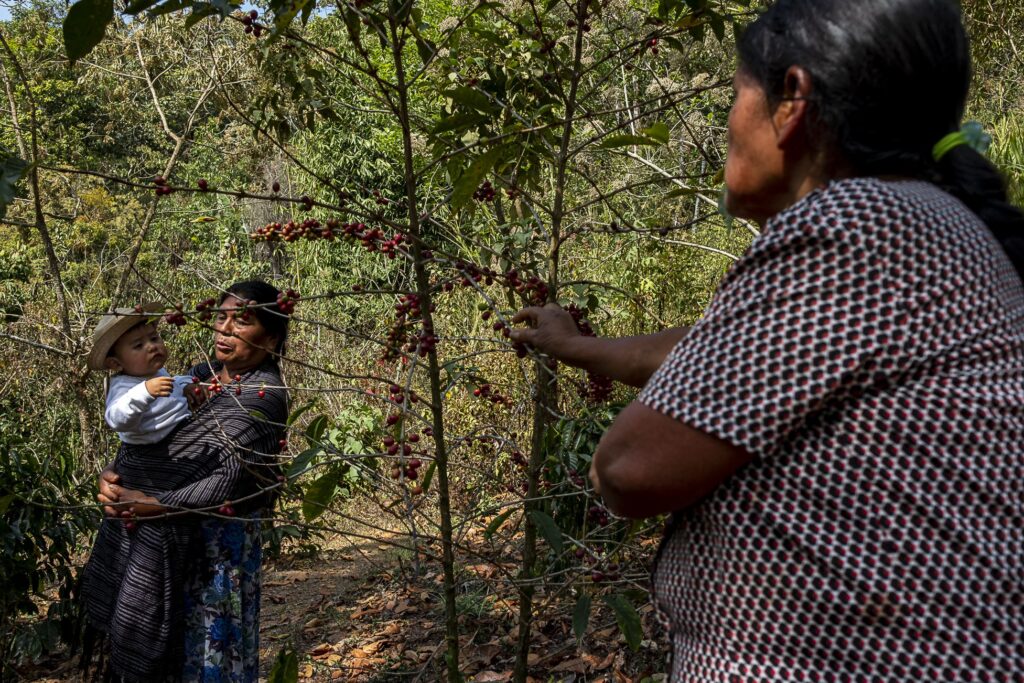
Agroforestry is the intentional integration of trees and shrubs into crop and animal farming systems to create environmental, economic, and social benefits.
Agroforestry objectives include: diversifying production, improve migration agriculture, increase organic soil matter levels, set atmospheric nitrogen, recycle nutrients, modify microclimate and optimize the system’s productivity respecting the concept of sustainable production.
Varieties matter, so does shade
Droughts have been challenging the southern Mexican state for decades now. The State Climate Change Program for Oaxaca for the years 2016-2022 warned that the majority of the state’s municipalities were exposed to a high risk of impacts of climate change.
When the rust destroyed the plants in the region, farmers who stayed started renovating their plantations. “Some were renovated due to the disease, others because of the plants being old,” Dominica López (63) explains and adds that the renovation is still ongoing.
“Every year we renovate a different piece of our land.”
Within years, local coffee producers have found a way to renovate effectively. At the beginning, they would plant varieties that were given to them by the government or different organizations but they were not always suitable for these soils and environments, neither were they resistant to the coffee rust. “Now we grow mostly Sarchimor, Marsellesa, Típica and Geisha,” Ortiz López states. In the small piece of her plantation where we start interviewing her, she has about twenty plants of Geisha and she was able to collect about 50 kilos of coffee cherries this last season. She is planning to plant more Geisha plants since there is a lot of demand for it in the international market. Though it also needs a lot of care, Ortiz López admits.
Nowadays, women do not rely on coffee plants from outside; they have their own nurseries and even seedbeds. In Buenavista, women work together and create their nurseries together. Most producers have their own nurseries.
“I have about 3,000 plants here. Apart from planting some on our plots, I am planning to sell them,” says Marbella López Feria (27), an agronomy engineer who is from a neighbouring village Reyes LLano Grande. She is a so-called community technician trained by the State Coordinator of Coffee Producers in Oaxaca (CEPCO).
This NGO unites about 3,000 small coffee farmers from across the state. They provide trainings, access to micro loans, and also support with selling coffee within and outside of Mexico. Currently, they also support agroforestry systems in Oaxaca thanks to the project funded by Livelihoods Funds.
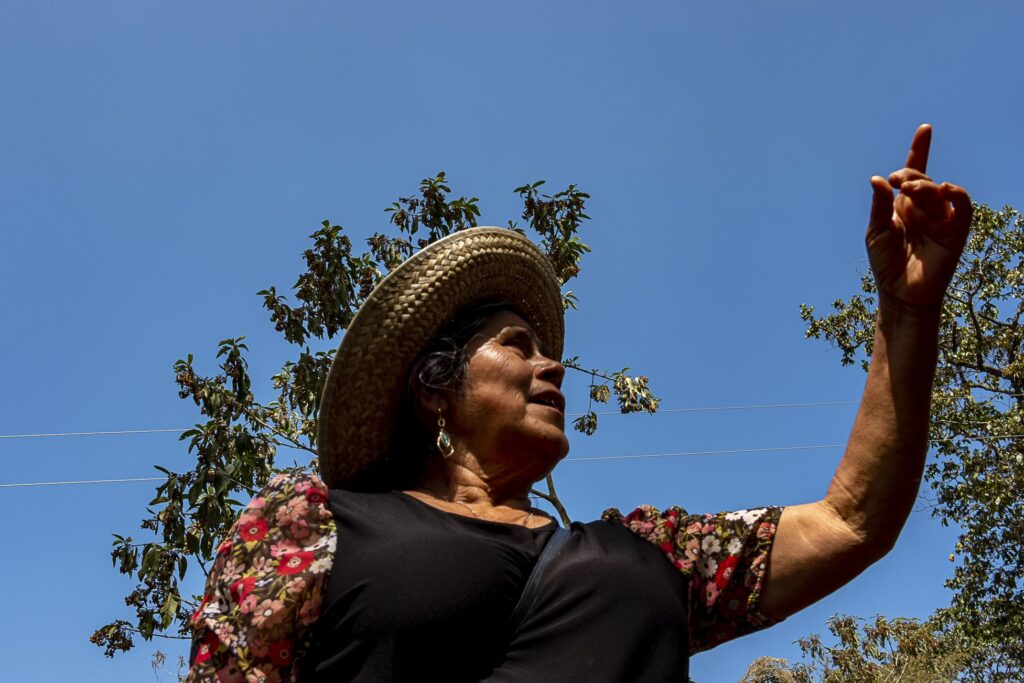
More than 40 per cent of coffee farmers in the collective are women and women also form approximately half of all technicians. “There might be even more women involved but plots are often on a man’s name even if the woman works the fields. Or women themselves were often not aware of all the activities they were doing at coffee plantations,” states Ana Tejero, responsible for the environmental oversight of CePCOs projects and activities.
"We work with young farmers and women because they are more vulnerable to climate change."
Ana Tejero
According to various studies, getting technical support on how to grow coffee is key to facing the impacts of climate change. One of the ways CEPCO supports small coffee farmers is to provide this technical support by training technicians from within the communities. However, there are still not enough technicians in Mexico due to a lack of funding and the lengthy process of capacitation.
Marbella López Feria has been in training for two years now. Her parents used to grow coffee while migrating temporarily to the US as well. Having to take care of her three younger sisters after the passing of her parents, she returned to her home village from Puebla, where she had been studying, and joined CEPCO.
“Coffee rust is not the only disease affecting plants, there are other diseases and pests present as a result of the climate becoming warmer here in La Mixteca. Coffee borer beetle is one of them,” she tells me. This beetle affects plants that have too much shade. It enters the coffee cherries and destroys them. “You can still use the grains but they will not be of the quality that buyers search for,” she explains. To get rid of the beetle, she created leaflets where she explains to the producers how to catch it in a three-liter plastic bottle where they put alcohol. It will attract the beetle, which will drown in the water afterwards.
Diversification and costly care
As we walk through Victórica Ortiz’ plots, she is proudly showing us her banana palm trees, mandarins and avocados that grow around her coffee plants. Marbella also has lemon trees and avocados in her plot.
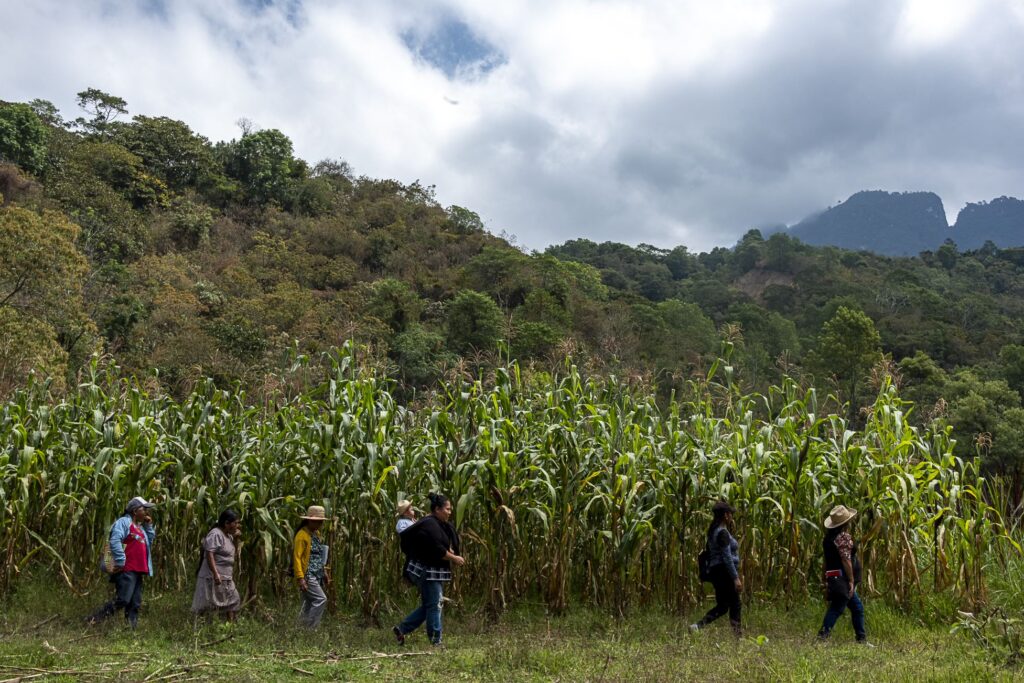
Diversification of coffee varieties and also of plants that surround them is key in times of climate change. If a disease affects one variety, a farmer loses everything.
Apart from this, they can get additional income by collecting fruit. However, it is not only about planting a tree, Ana Tejero warns. “A complete restoration is necessary, including restoration of soil, water capturing systems, preparation of compost.” In La Mixteca, the majority of producers have their worm composts to provide nutrition for coffee plants. One of the things they feed worms with is the coffee husks.
Apart from applying organic fertilizers, coffee producers have to clear their plantations of weeds and unwanted plants at least twice a year. This used to be the job of men only, Dominica López states, “But now, we learned how to work with machetes too”, she adds. “In my plantation, I have weeds that grow very fast, clearing it twice is not enough with young coffee plants.”
Local families usually hire workers to help with clearing, compost application, or harvest. Migration, however, makes costs higher since men are gone and thus there is a lack of labor force. “Those who stay know there are not enough workers so they ask for more money,” Victorica Ortiz adds.
While taking care of coffee becomes more expensive every year due to climate change, the price of coffee decreased this year - again.
When CEPCO buys their coffee, women in Buenavista get a little more than 60 pesos (equivalent to 4.30 euro) for a kilo of washed coffee grains of mixed varieties. This is the cheapest way they can process grains. The price they earn can go up if they process their coffee differently, for example selling it as parchment coffee or even specialty coffee. This however, generates additional costs and also requires more technical support.
Women from a local group get incentives from the government program called Bienestar. “I receive 6,000 pesos once a year,” Dominica López states. Another federal government program that coffee producers might benefit from is Sembrando Vida. This program offers monthly incentives to small farmers to diversify their plantations and (re)create them into agroforestry systems. The money support often comes with trainings and seedlings.
Also, CEPCO recently provided drying beds for thirty women producers in Buenavista. “It helps us keep coffee dry even if we are in the fields when it starts raining,” López states. Other than that, micro loans are also a way to go for small coffee producers.
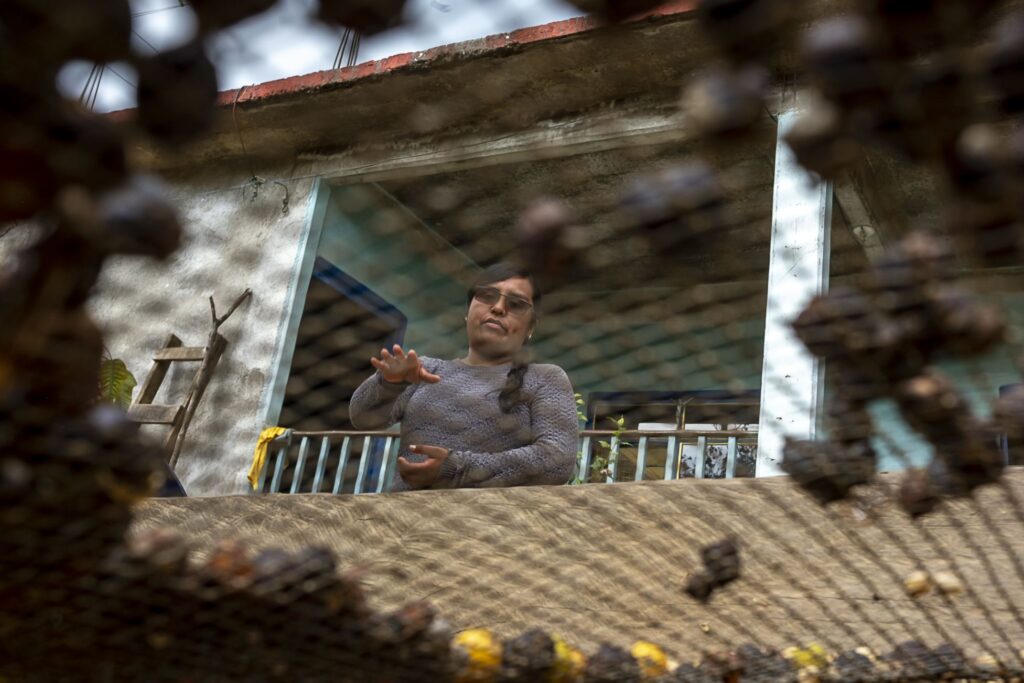
"Even though farmers are those who sustain cities, we are not paid well enough," all women agree. "No matter how much we work, we do not advance fast enough (in what we earn)," Dominica López states.
Professor José Luis Jaramillo Villanueva of Colegio Postgradual in Puebla has conducted a study on small coffee producers in Oaxaca and Puebla. The results of his research suggest that having a high income increases the likelihood of coffee producers taking measures to adapt to climate change. “While I do not have the evidence yet, the hypothesis is that if it is temporary migration, the remittances are subsidizing the production of crops such as coffee and corn. If the income from the sale of coffee represents an important part of the family’s income, the producers are carrying out adaptive measures, mainly changing to varieties resistant to pests and diseases and increasing the shade at plantations,” he states.
The study by Paul Rogé from Michigan State University suggests that climate change adaptation by small farmers in La Mixteca Alta is much more than just a set of farming practices. It involves community action to tackle collective problems. Women in Buenavista are a clear example of this.
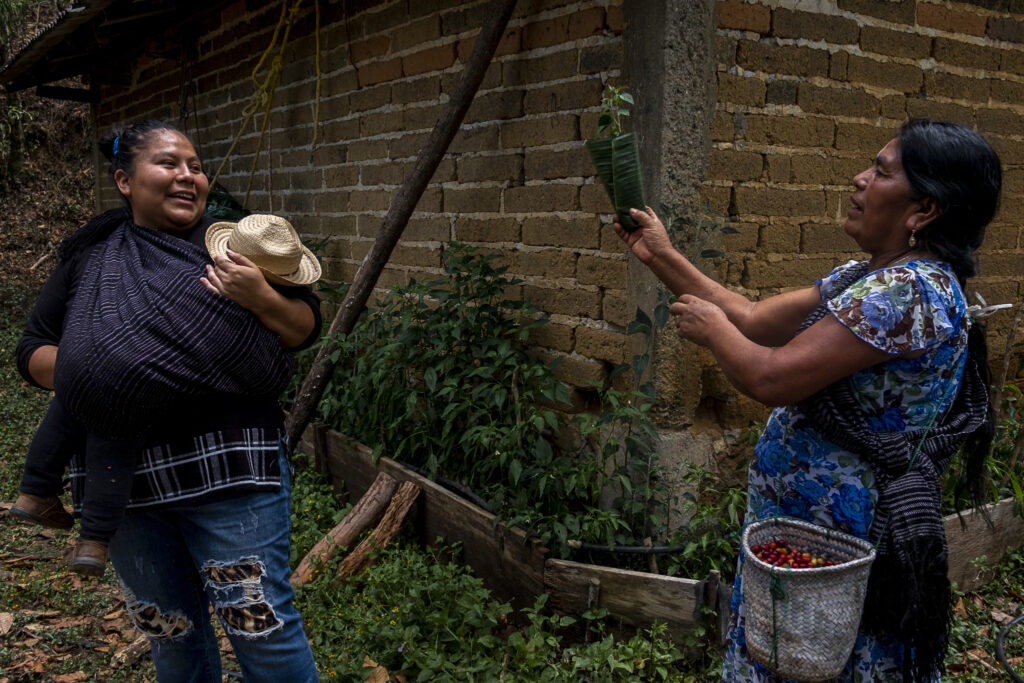
Laughter fills the air as we gather in Victórica Ortiz’s yard after visiting a nearby plantation. The local women here are both vulnerable to the low prices of coffee and strong; for often it is these women who make coffee production possible. They also participate in general assemblies in the village and thus become part of local politics and decisions made within their community. “In recent times, women are no longer confined to their houses. With many of their sons now migrating, women are helping their husbands in the fields, venturing out of the house to do so,” Dominica López suggests. And some men, on the contrary, help with housework. “It all depends on how we, women, teach our sons.”
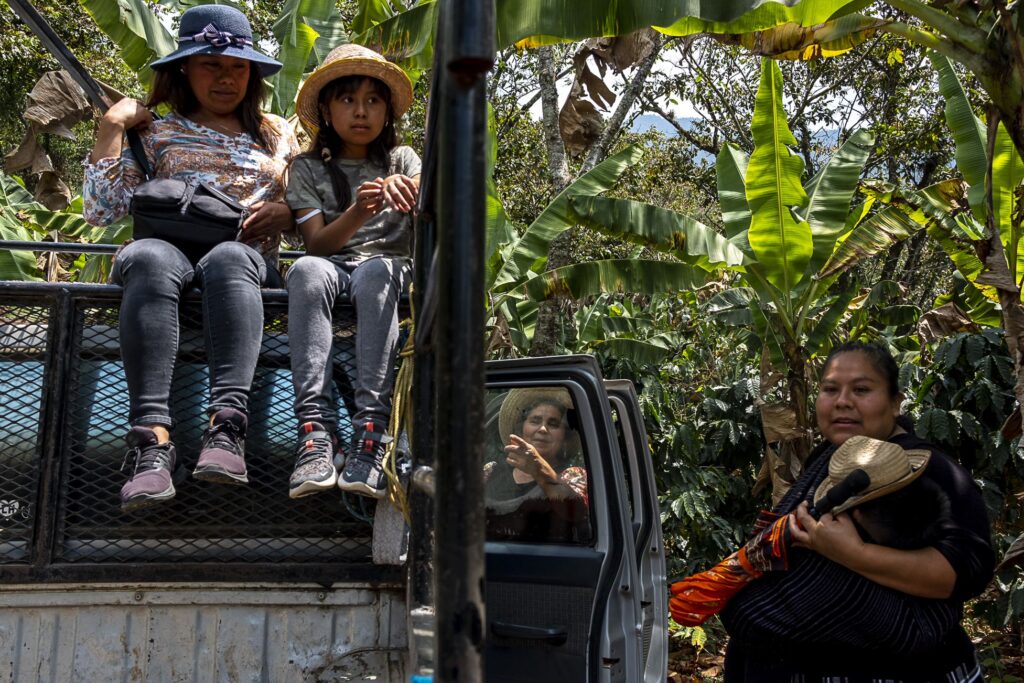
About the authors
Read more in this series

The International Seabed Authority is supposed to ensure that profits from the deep sea are shared with all mankind. But so far, a few companies seem poised to take a majority share.
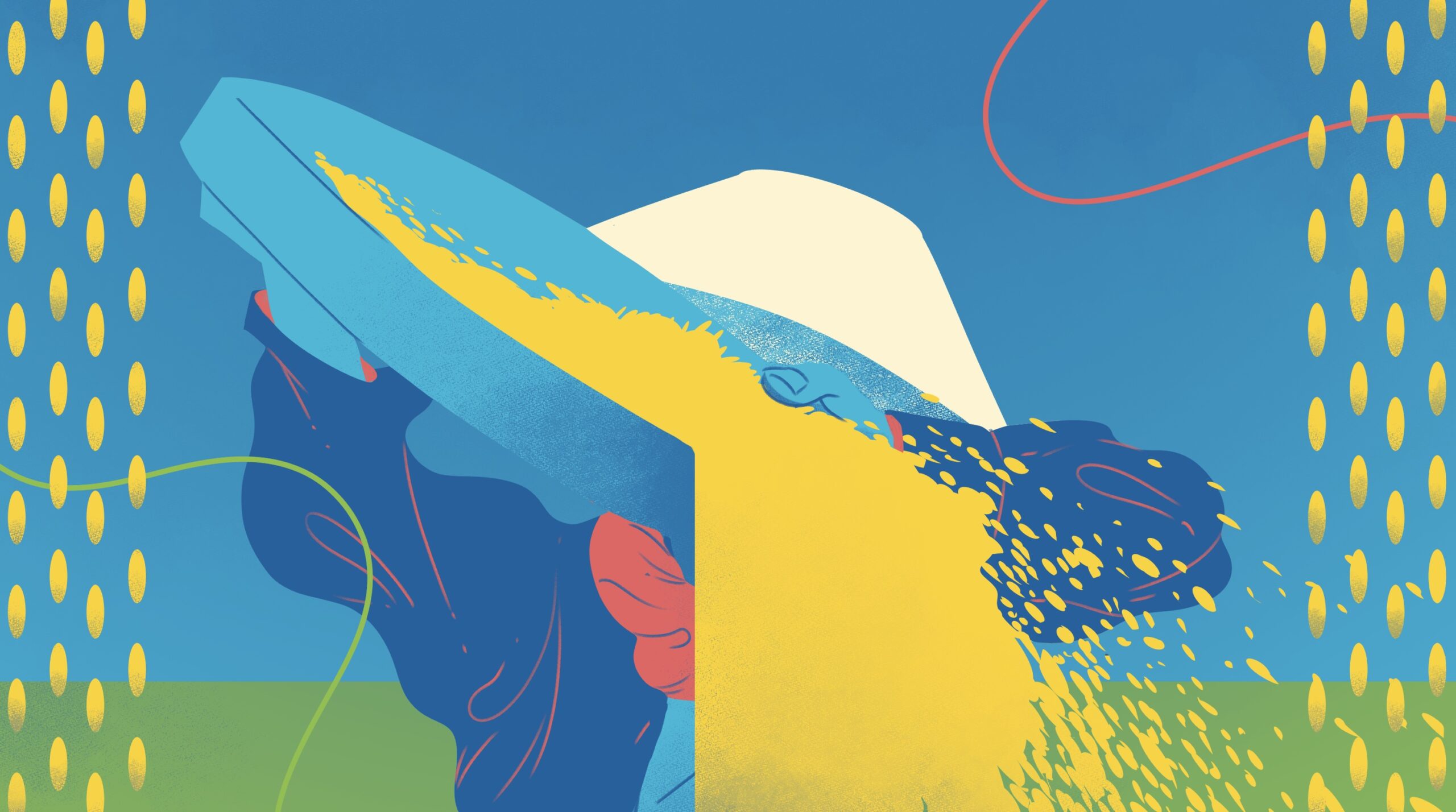
For the first time ever, large quantities of the genetically modified “golden rice” were harvested in the Philippines. It is supposed to save children’s lives. Rice farmers, nutrition experts and mothers report on their experiences.
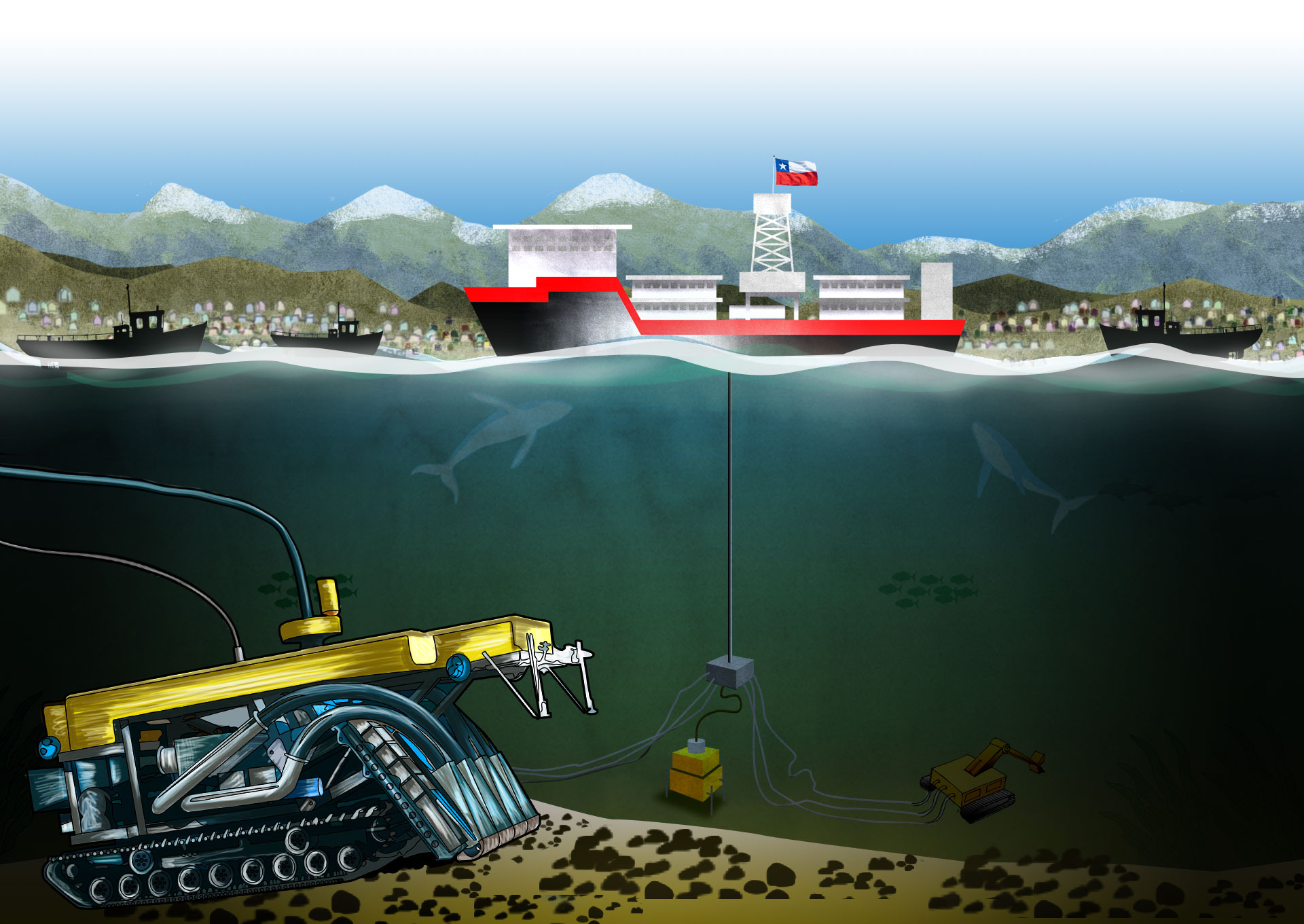
After the international negotiations on deep sea mining, it is worth asking whether this activity could be developed in the future in Chile, a mining country whose sea is almost five times larger than its continental surface. While some say that “it does not make sense”, others suggest that it could be an alternative to reduce land-based mining conflicts.

In Modhera, no one pays for electricity any more. Instead, villagers look at their electricity bills every month to see how much money they’ve earned from selling solar-generated electricity to the main grid.
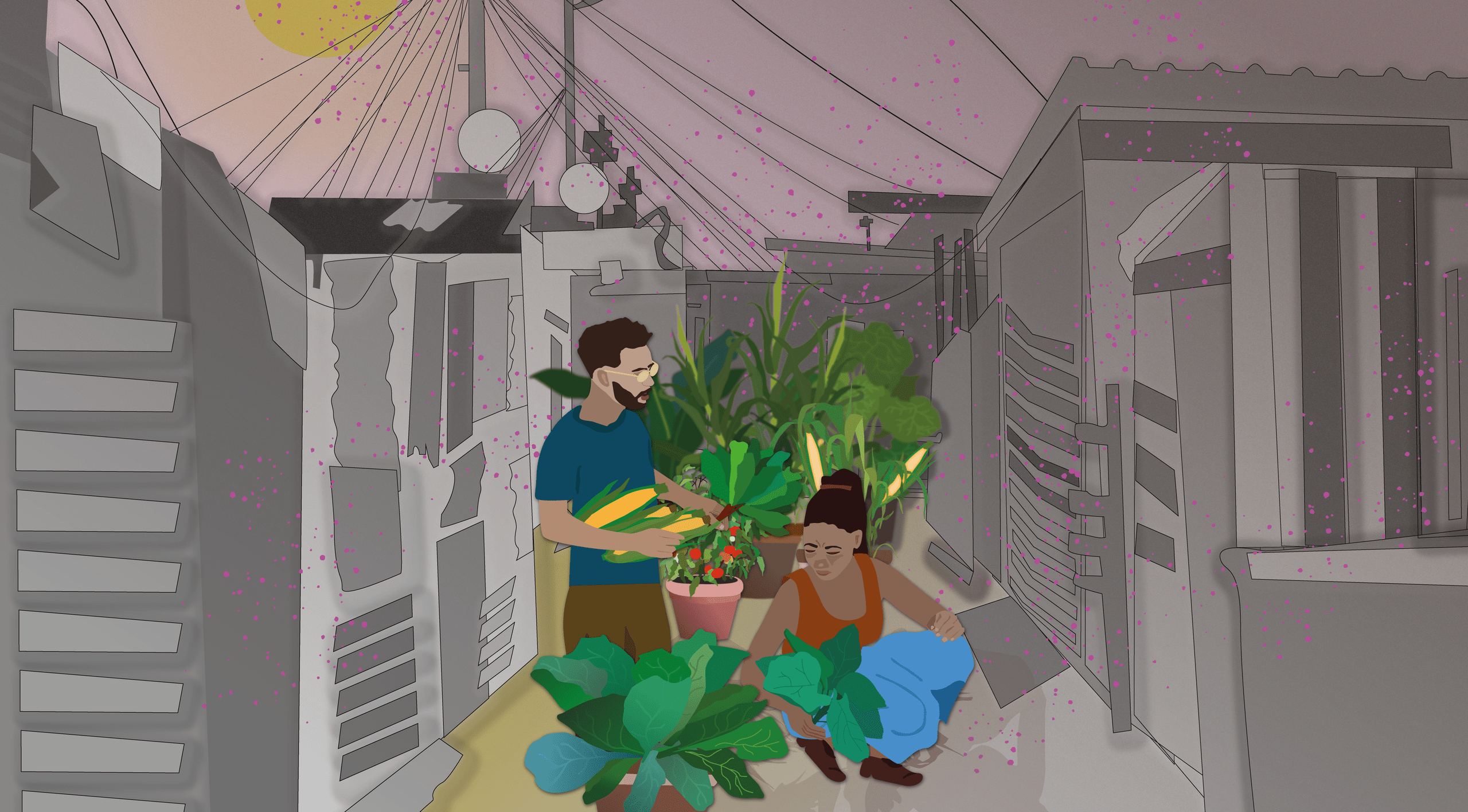
“We are farming sustainably and extremely efficiently, we use 95% less water than traditional farming, and we are net carbon negative, because we use renewable energy,”

Proponents say that mining the deep seas will provide a nearly unlimited resource of valuable metals, solving the problem of where to get the materials needed for the green energy transition, with the profits shared by all mankind. However, the pressing question remains: Can we justify the costs?
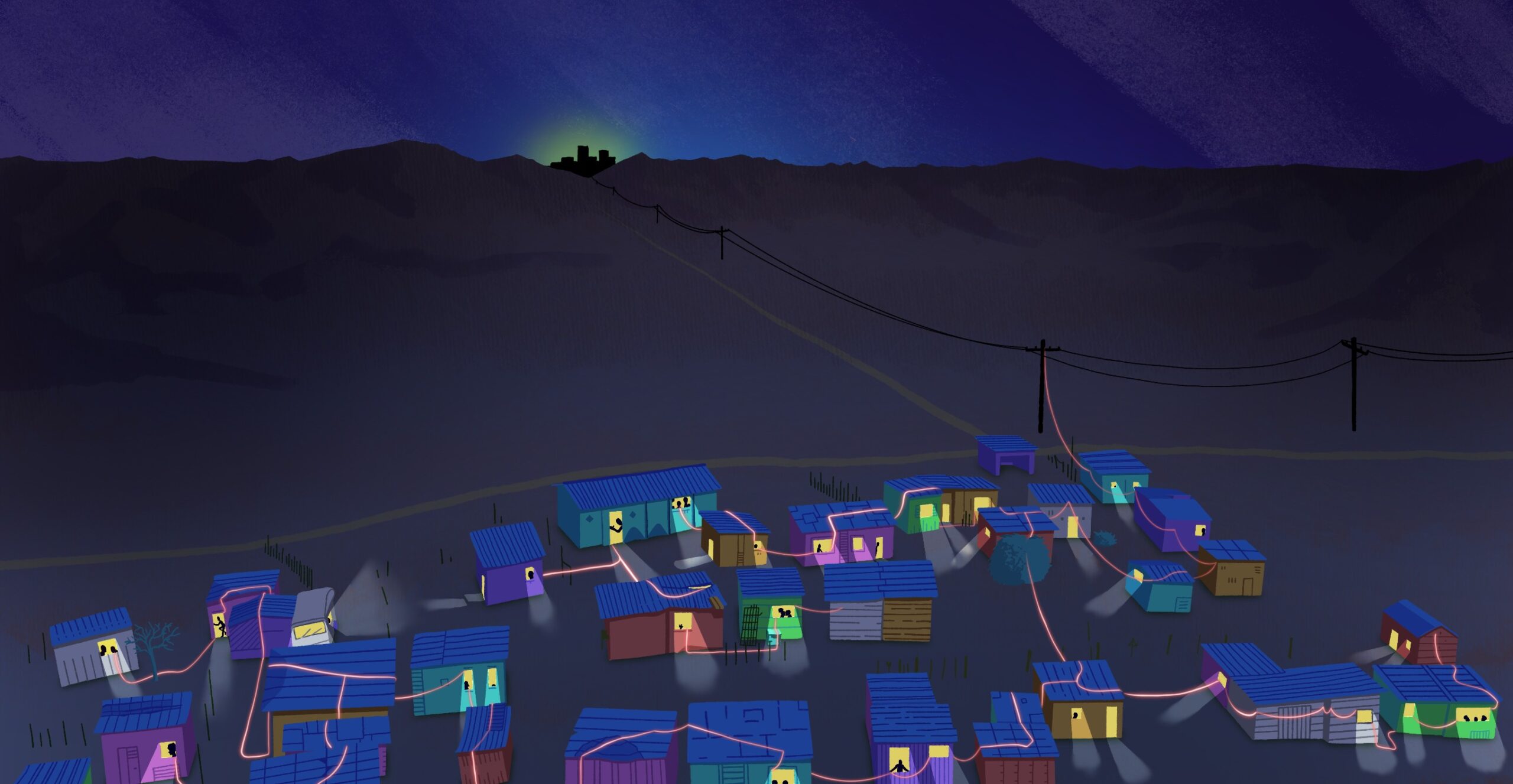
Namibia is poised to turn its sun-soaked weather into a hydrogen-fueled solution for Germany’s energy problems. But what problems will green hydrogen solve for Namibians?
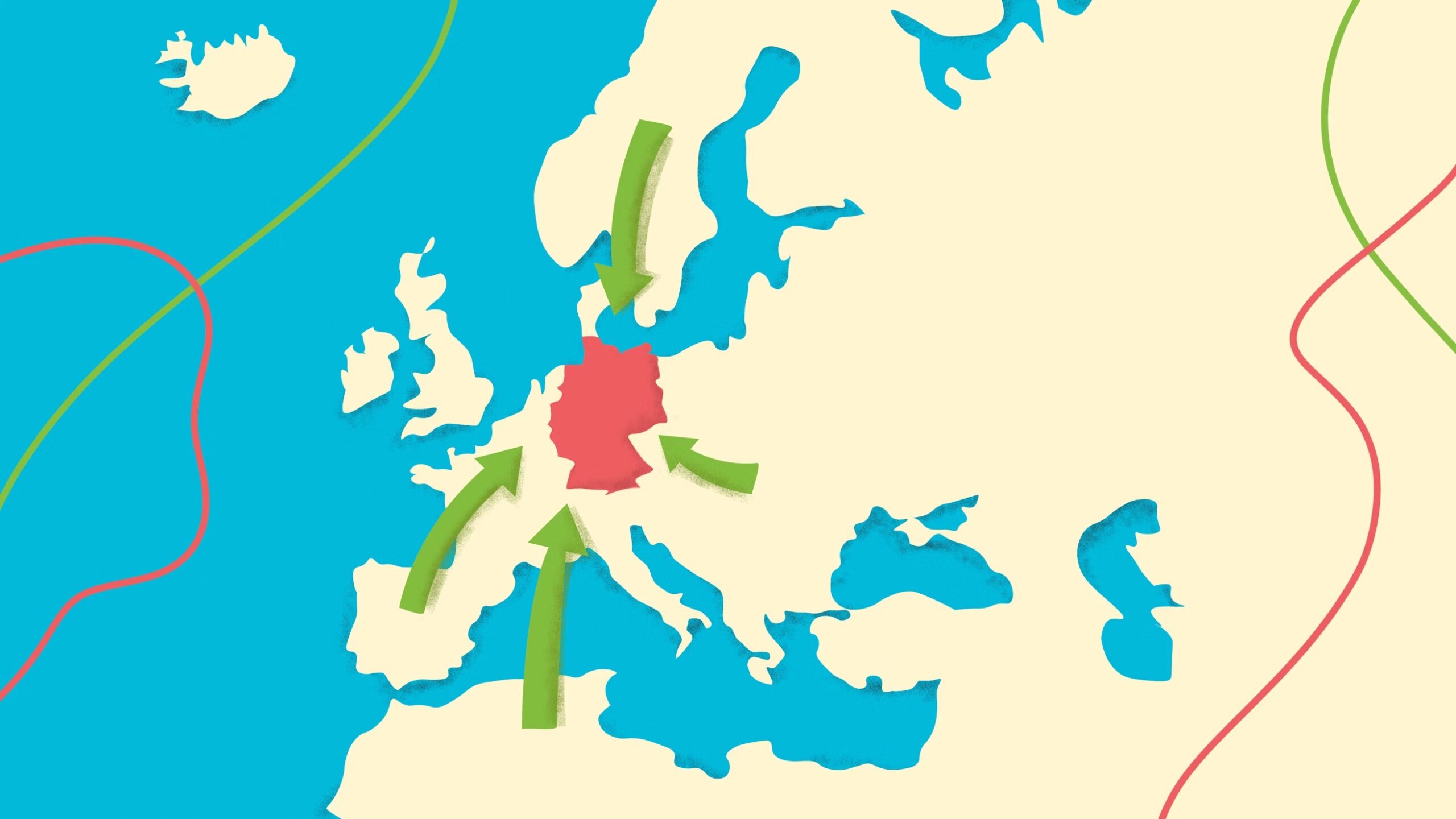
Germany already consumes more hydrogen than it produces, and leaves a significant carbon footprint. For the energy transition, the country will need to import cleaner green hydrogen, but from where?

In Buenavista, every woman we talk to has some family member on the other side of the northern border. La Mixteca region in Oaxaca has some of the poorest regions in Mexico in general and migration has for decades been a strategy for families to make ends meet. As men migrate, women are often the ones passing on the knowledge as to how to grow coffee.

With the rising urgency of the Climate Crisis, green hydrogen is the shiniest newcomer in global conversations on energy production. However, with sub-Saharan African countries contributing less than 3% (0.2% for Nigeria) to global carbon emissions, the more pressing question is how the continent can harness its existing resources to sustainably meet its own energy demand for economic development and poverty reduction

This project was funded by the European Journalism Centre, through the Solutions Journalism Accelerator. This fund is supported by the Bill & Melinda Gates Foundation.

